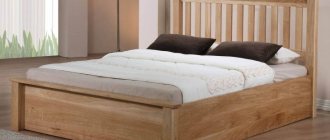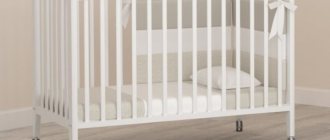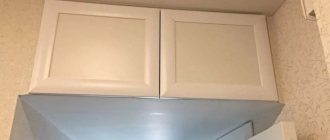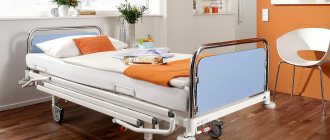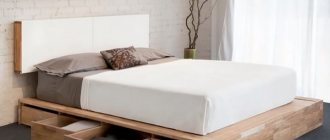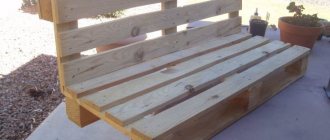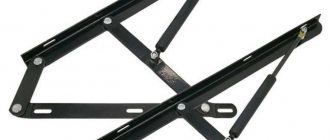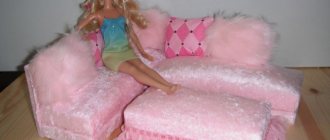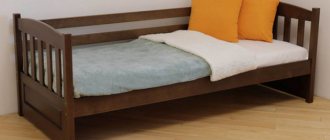<
>
When choosing a bed for a child, you need to be guided not only by preferences in its design, but also pay attention to its quality, comfort and functionality. Of course, you can buy a sofa “for growth”, then you won’t have to think about changing the bed along with the baby growing up. However, a bed is the best solution for a child’s bedroom, since it can not only be equipped with additional functionality, but also provide a sound sleep for the child. A wide selection of models, bases and mattresses will allow you to choose the best bed option for your child.
Compared to a sofa, a bed also benefits in other respects: there is no need to disassemble and reassemble the sleeping place every day, the child can independently make the bed without the help of adults, while parents will have to help with cleaning the sofa for quite a long time. In addition, the bed can be equipped with any type of mattress, exactly the one that is most suitable for the child in terms of hardness and size.
Why make your own furniture?
Mass production does not always satisfy everyone with its products. And this causes displeasure for some, while giving others an incentive for creativity.
What does a home craftsman get from the hassle of making furniture with his own hands?
- Savings. Every job costs money. Doing this work eliminates the need to pay for it.
- Complete freedom in planning the space and creating functional furniture.
- Maximum compliance with your needs. Independent production of furniture allows you to build a furniture complex that meets your own needs and ideas about comfort and functionality.
- The joy of shaping your own living space. Here we move away from rational motives and enter the realm of creativity.
Conclusion
Choosing an extendable children's bed is not as difficult as it seems at first glance if you know all the features of the product and understand the differences between models from different manufacturers. The video will help you understand the individual nuances of the topic even better, and if you have any questions, write them in the comments.
Did you like the article? Subscribe to our Yandex.Zen channel
August 4, 2022
Children's design, Furniture
If you want to express gratitude, add a clarification or objection, or ask the author something, add a comment or say thank you!
Concept and design
Creating a crib begins with answering a number of questions:
- What age do you need a bed for?
- Does the bed need to be transformable for different ages?
- How many beds do you need?
- Do you need a stationary or folding design?
- Will it be just a bed or a complex with various functions?
The dimensions of the future product, preferences for materials and many other design decisions depend on the answers to these questions.
For the little ones
A newborn bed should provide safety for the baby and comfort for its mother. There are basically two options here:
- a separate crib with sides and a bed at least 500–600 mm high from the floor;
- a side bed, the bed of which is located at the same height as the mother’s bed, and the sides limit it only on three sides.
An additional cot should not be made longer than 800–1000 mm, but a separate bed should have a length of 1200–1400 mm and a removable side.
The child will be comfortable in it until he is 3 years old, and maybe longer. You should immediately provide for the possibility of rearranging the bed so that you can lower it lower when the baby grows up.
Bed for growth
Another interesting option for a “growth” design is a transforming bed. This is the implementation of the idea of universal furniture, which is transformed depending on needs.
The crib has a modular design, and its purpose can be changed by rearranging the modules. In its original layout, it is adapted for a newborn and, in addition to a place for the child, contains a changing table and drawers for storing linen and other useful things.
As the baby grows, it becomes cramped in the “nest”, which is only about 800 mm long. Then the changing table is removed from the lower body and becomes a separate cabinet. The baby bed is also removable and can be used in the play area. And the remaining structure is a new version of the bed, which will last up to 5-7 years.
The design of the transformer is clear from the diagram below.
Note! Here and below, dimensions are indicated only in millimeters. This may seem inconvenient and unusual, but the use of millimeters eliminates fractional numbers that are not immediately grasped by the eye, take longer to pronounce and are more difficult to perceive by ear. Measure in millimeters to reduce the chance of error!
Not just a bed
In its simplest form, a bed is simply a bed with sides, mounted on legs or other supports. Here is a drawing of a classic chipboard design.
To implement it in a material, you only need to cut out the parts of the required sizes and connect them correctly. It's not difficult, especially if you use the tips given later in this article.
But a children's bed should not perform only a utilitarian function. You can and should make interesting furniture for children. Even for a simple thing, a small person is able to come up with a dozen uses that are not provided for by its design. It is worth entering the world of children's fantasy and making the child's room a field for games and exploration.
Bed-toy
The bed can take any shape. Only the plane of the bed and the safety of the furniture remain mandatory. A good example of interesting furniture is a car bed.
The simplicity of its design is evident from the given frame diagram.
In this design, elastic plywood slats are used as a base for the mattress, which can be purchased from companies that sell furniture components. But you can do without them by laying a rigid bed made of chipboard or plywood 10 mm thick on the support rails.
Bright drawings on panels are quite easy to make. To do this you need:
- find a suitable image in electronic form;
- find a printing or advertising company that will adjust the design to the required dimensions, print it on vinyl film and cut out the contours;
- apply film to the workpieces, mark the contours, cut out the parts and process their edges;
- stick the film.
The same approach can be applied to other furniture elements, for example, cabinet fronts. To do this, you can use full-color printing, and one-two-three-color applications made from self-adhesive films of different shades.
Composition of functions: a bed as part of a household, work or play complex
A child will definitely like a non-boring bed with an interesting shape. This effect is achieved by furniture-toys, furniture-fairy tales. But you can turn to the idea of a transformer and combine the functions of a bed and other furniture. This will make the bed interesting and save space, which can never be too much in a child's room.
Children's sliding sofa
A children's pull-out sofa bed not only saves space, but also gives the child the look of a living room. When folded, its dimensions are quite suitable for a small child; when unfolded, it is suitable for a schoolchild and teenager.
- Various folding mechanisms are used: book, accordion, cascade. However, the retractable one should be considered the most successful, since the child needs the least amount of effort to move it.
- When choosing a sofa bed, special attention should be paid to the material and fastening of the frame. A product designed for a child must be especially durable.
- The preferable option is where a slatted base is formed under the berth.
- Children's sofas are decorated in a very varied and bright way, so choosing the right model for the children's room is not difficult.
Children's sliding sofa
However, among all the options for children's sliding furniture, the sofa ranks last. When unfolded, it does not create a flat surface; there are always differences in height between different parts. This is extremely undesirable for a children's bed.
You can use a sofa as a sleeping place no earlier than 12–13 years old, when the spine is fully formed.
Children's sliding beds are very diverse in design, filling, materials and, accordingly, cost. It’s not easy to choose among them, but the time spent is worth it: a high-quality, correctly selected sliding bed will last for ten years.
Bunk and other “multi-bed” options
If there are two or more children in a family, then it makes sense to combine their sleeping places in one complex. The most obvious and common solution is a bunk bed. When creating such a bed, easy access to the second tier is ensured. For this purpose, stairs are made or other solutions are used.
In this drawing of a bunk bed made of chipboard, you can clearly see that all the parts are connected in such a way that they form rigid box-like structures. The side posts provide rigidity in the transverse direction, the rear wall provides rigidity in the longitudinal direction, and the stock determines the rectangularity of the structure in plan.
The arrangement of parts in three planes is a fundamentally important point when designing furniture from sheet materials.
By following this simple rule, you can give free rein to your imagination and create very interesting and reliable furniture.
Bed with
Bed-work area
A radical solution for several beds in a limited area
All these structures can be made from wood, or from more convenient slab and sheet materials made from wood.
How to choose?
Children's sliding beds are the most popular option for apartments with a small area, where every centimeter is of great importance. A children's room is a space that should not be cluttered with too much furniture. All solutions should be as compact and functional as possible, but at the same time comfortable for the child. A growing child needs as much space as possible to realize his play ideas. It is for these reasons that many parents choose extendable cribs.
Any model of a sliding bed must be equipped with a specially selected orthopedic mattress.
Let's figure out how to make the right choice of an extendable children's bed and what you need to pay special attention to when purchasing.
If you want to get additional storage space along with the bed, then pay attention to models equipped with drawers.
- When choosing children's furniture, you should immediately take care of an orthopedic mattress, which will ensure healthy sleep and help the child develop correct posture.
- Material. One of the most important indicators of a high-quality children's bed is the material from which the sleep frame is made. A children's bed should be made of environmentally friendly materials - the child's health depends on it. For this you can use natural wood: ash, beech or environmentally friendly chipboard. The material must have a quality certificate.
- Visual inspection. If children's furniture was made to order, it must be carefully inspected for defects before installation. If you purchased a ready-made model, you should try out all the retractable mechanisms; they should work smoothly and not “stick.”
- Dimensions. Before purchasing, you need to measure the area of the room. At the same time, you need to choose a bed that will match the child’s height. Don’t forget about the design of the children’s room, everything should be harmonious. Manufacturers offer a large selection of children's sofas of various sizes, shapes and colors. Also in the “I'm growing” line are models of a children's loft bed, and sofas with a pull-out bed.
Any interior solution will look complete if you use a sliding bed.
A little about materials
Modern furniture is overwhelmingly made from panel materials, which are made from wood chips and small fibers.
Chipboard is the basis of furniture
The main construction material used for furniture is laminated particle board (laminated chipboard), often referred to simply as chipboard. Products made from it do not require any additional processing and virtually no maintenance. The surface decor is set at the production stage of the slab, and the assortment allows you to choose from several dozen options.
Chipboard is made from small wood shavings using urea-formaldehyde resins, which is why the material evokes a wary attitude. But the furniture boards produced today are approved for use in residential premises and in children's institutions. Most of them have an emission class of E1, and some, such as the Egger stove, have an E0. They are reasonably considered harmless.
Chipboard is a fairly plastic material. Self-tapping screws with a diameter of 3–4.5 mm are screwed into the slab without pre-drilling, and when installing fasteners, door hinges and other fittings, correction of the fastening points is allowed, although this is undesirable, since it reduces the holding capacity of the screw.
When creating structures from chipboard, it should be borne in mind that even a seemingly strong stiffener made from a 50–60 mm high plank can, under load, “crawl” over time and bend in an arc, which at first glance seems impossible. Any load-bearing elements that work in bending must have a cross-section in the bending direction of at least 100 mm.
Fiberboard – auxiliary material
Fiberboard is a wood-fiber board. Despite the word “plate” in the name, it is still a flexible sheet, which most often has a thickness of 3.2 mm. Laminated fiberboard is used for furniture. It is used as the back wall of cabinets, cabinets and as the bottom of drawers. Fiberboard serves as a “rear” membrane and performs an important function - it gives rigidity to box-shaped structures, which without it would not be able to maintain their shape.
Facades and other “special” elements
Parts that have special design and aesthetic requirements are made from Medium Density Fiberboard (MDF). This board has a higher density and strength than chipboard. Its facade parts are decorated with figured milling, and it is covered with vinyl film or painting. Cabinet doors, end and side (front) panels of beds, and countertops are made from it.
Tree
Natural wood is a material that in recent decades has acquired an almost magical aura of “environmental friendliness”. There is no doubt that wood is indeed more pleasant to the touch, smell, and taste than any of the composites. However, when comparing it with other materials, it should be taken into account that wooden furniture parts are treated with stains, antiseptics, and varnishes. Adhesives are used in their manufacture and assembly of products. That is, the naturalness is not so absolute; this material is much more complex to work with, and more capricious to use than the same chipboard. And yet, wood is used in modern furniture production. Basically, these are products and structures that require high strength with a minimum cross-section of parts or special aesthetics. This:
- ladders, rungs and steps of ladders;
- load-bearing beams, racks of light structures;
- front parts - doors, shields, facade panels, handrails.
Lightweight structures - only made of wood.
Hardwoods are most often used - oak, beech, ash. Less often - pine or alder. This choice is due to the fact that hard rocks hold up to grinding better and, if properly processed, do not create the danger of splinters. In addition, these rocks are less susceptible to warping due to seasonal changes in humidity.
Features of interior solutions with a pull-out children's bed
The children's room has many functions - the child studies, plays and relaxes here. And one should not interfere with the other, especially if there are two or more children. That is why the bed plays a significant role in the interior. Children's furniture allows you not only to save such important space, but also plays a significant role in shaping the interior of the room.
Extendable children's beds provide a large number of advantages for buyers.
The most ideal solution for properly organizing the sleeping area of several children is a pull-out bed with two sleeping places. The original design of the children's extendable bed allows it to be placed along any wall, while it takes up minimal space. Before going to bed, the lower tier pulls out and an additional sleeping place appears. This design is simple in its execution, but at the same time durable, as it is designed for long-term use. You can choose such a sleeping place for both a small child and a teenager.
Furniture manufacturers offer the customer a wide range of color palettes and designs.
Quite often there are unusual designs in children's pull-out beds, where the lower tier is hidden in a chest of drawers or the upper tier serves as a desk. There are also options that are made like a bunk loft bed, but the lower part moves out on wheels. The color schemes are so diverse that they are quite capable of complementing any design of a children's room.
The “I’m growing” bed is one of the brightest representatives of the “Smart Furniture” category.
"Smart" furniture
A children's sliding bed appeared not so long ago, but has already managed to win the hearts of many parents and their kids. This furniture is made in a variety of options, but the essence of their use remains the same - rationalization of the space of the children's room.
There is an option for a sliding bed with possible adjustment of the height level of the lower floor using a special automatic mechanism. This functionality makes it possible to place beds on the same level or combine them into a single sleeping place.
The extendable crib fits perfectly into any interior of a child's room.
The innovative design of some models of transforming cabinets with children's blood is capable of changing their planes. Such a system folds inward or, conversely, can be folded out into separate panels, resulting in the formation of additional storage modules, or can be used as a study table.
Stylish and modern model of an extendable crib for a child.
The most interesting children's sleeping furniture is presented in this year's new products - a bed built into the wall. This model frees up maximum space both for the child’s activities and for active games with peers. The storage system here deserves special attention - it is presented in the form of bookshelves and drawers, which are also located in the wall. Access to them opens when the bed is pulled out.
High-quality children's sliding beds have a very attractive appearance.
When choosing a children's sliding bed, it is very important to pay attention not only to the appearance, but also to the quality of workmanship. Convenience in everyday use is also important, because first the parents bear the responsibility of organizing the children's room and only then, as the child grows older, the baby himself will tell you what will be best for him.
Features of furniture production and self-made furniture
Furniture production uses the principle of simple work with complex components. Chipboard or wooden beams, fittings and fasteners are manufactured at enterprises that have everything necessary for this and ensure low prices due to mass production.
To produce high-quality furniture, it is not necessary to have complex equipment and production facilities. All high-tech, but routine operations can be entrusted to those who specialize in this, and you yourself can concentrate on creativity and on obtaining the final result.
Furniture manufacturing comes down to assembling products from finished parts and fittings. This is exactly how small furniture companies operate, and the lack of their own production facilities does not hinder them at all. The same can be done at home. To do this, it is enough to have the simplest household-grade power tool.
Let's start to act
The algorithm described below is designed to ensure that all work requiring the use of special equipment will be entrusted to specialized companies.
Design and project
First you need to come up with a bed design and make a drawing. You should start with overall dimensions and general views. Then the details are clarified step by step. Below is a sketch that you can already work with.
Here the dimensions are indicated in sufficient detail, on the basis of which the detailing is done. Unmarked dimensions are calculated based on the indicated dimensions and the thickness of the material. If any details are not clear from the general sketch, then additional drawings need to be made showing individual components or views in more detail.
For complex parts, such as the tabletop in this sketch, overall dimensions, dimensions of key elements, and rounding radii are indicated.
The project must take into account the maximum possible dimensions of the parts, which are limited by the format of the chipboard sheet. As a rule, this is 2750x1830 mm minus 10‑20 mm for trimming edges. Please check with the company where you ordered the material and cut it into parts for specific restrictions.
The slab is cut on a special cutting machine, which ensures cutting accuracy and cleanliness. It's best not to try to do this with hand tools. The savings achieved in this way do not justify the loss of time and deterioration in quality.
Detailing
After drawing up detailed drawings, detailing is done - a list of parts with their overall dimensions and an indication of additional processing. Below is a detail fragment shown as an example.
| № | Detail | Length | Width | Kolic | Rotate |
| 1 | Racks 1 | 1355 | 834 | 2 | No |
| 2 | Racks 2 | 1360 | 830 | 2 | No |
| 3 | Side | 1822 | 296 | 2 | Yes |
| 4 | Cabinet front | 1500 | 396 | 2 | No |
| 5 | Cabinet facade | 550 | 396 | 1 | No |
The first is to indicate the size along the structure of the pattern on the chipboard. The second - across. The last column indicates whether the part can be rotated during cutting. For example, if you indicate “yes” in the “Cabinet front” line, then the pattern on one door may turn out to be vertical, and on the other - horizontal.
In addition, you need to indicate which sides of the parts are covered with edging tape. This is indicated by underlining the corresponding number. One underline – one side, two – both on parallel edges. Underlining two numbers means edging the edges in both dimensions.
Important! When determining dimensions, you need to take into account the thickness of the chipboard. Usually it is 16 or 18 mm. When choosing the color of a material, you need to immediately clarify in what thickness it is available. When determining the dimensions of facades, use the rules below.
- For overhead facades that are applied to the ends of the cabinet or cabinet parts, the size is taken to be 4 millimeters smaller than the size of the module or the geometric calculated space for the facade.
- For internal facades that enter the opening, the size is taken 5-6 millimeters less than the size of the opening on each side. For large parts, it is necessary to provide gaps around the entire perimeter of at least 3 mm.
- The fronts of the drawers are designed so that there is a gap of 3 mm between them.
- If it is planned to cover the ends with edge tape with a thickness of more than 0.5 mm, then it is taken into account when calculating the dimensions of the parts.
Using the detailing table, a company selling chipboards will draw up a cutting map, determine the required number of sheets, cut them into parts and cover the ends with edge tape.
The processing of complex parts must be indicated separately, in the form of sketches indicating the places of rounding and their radii. If the shape is not described only by dimensions and radii, then the contours can be set using a coordinate grid or you can independently cut out a template from fiberboard and send it to work.
However, if you have a jigsaw and a belt sander at home, you can make complex parts yourself. For a jigsaw, you need to use a carbide file “tooth up”, make the cut at a distance of 3-5 mm from the finishing contour, and then remove excess material with a belt sander. When processing complex parts yourself, you will have to take them separately to edging or glue the ends yourself.
Important! When grinding ends of complex shapes yourself, you must ensure their perpendicularity. Otherwise, when gluing, the edge tape will not lie along its entire length, but will go to the side.
When designing curved parts for a PVC edge with a thickness of 2 mm, it is necessary to provide external roundings with a radius of at least 50 mm, and internal roundings - no less than what the tool used can handle. For a hand grinder this is usually at least 300 mm.
Thin and thick plastic edges
At home, PVC plastic edges 0.4–0.5 mm thick are glued with Nairit contact glue or similar. The protruding edges are carefully cut off with a sharp knife, and the resulting corner is smoothed with thin sandpaper and polished with felt.
Trimming edge edges
The melamine “paper” edge is easier to glue. It is smoothed with a hot iron and additionally pressed with a flat bar with a piece of felt or other dense fabric.
It is better to cover the edges of parts that often experience increased loads, such as the edge of a table top, steps of a staircase, or the upper edge of the side, with 2 mm thick plastic tape. This is done only on a special machine using thermoplastic glue, and the edges are processed with a router.
What you need to know about this furniture option
So that you can immediately understand whether this solution is suitable or not, we will analyze its pros and cons, as well as the main features of such structures.
Advantages
The main advantages can be considered the following factors:
| Illustration | Description |
| Long term of use . On average, such furniture options last about 10 years, which is a lot, considering the fact that the child is actively growing and his height changes noticeably every year. You solve the problem at one time and then don’t worry about the fact that the bed has become too small and it’s time to change it to provide the child with maximum comfort. | |
| Functionality . In addition to the sliding mechanism, the design may include other additions: a drawer for bed linen, a cabinet that is used in the design. Thanks to this, you save not only money, because now you can do without a chest of drawers or buy a smaller structure, but also space, because the space under the mattress is put to good use. | |
| Space saving . A sliding structure is easier to fit into a room than a larger fixed bed. In addition, you can fold the system during the day so that it does not take up space. This factor is very important if you have a small apartment and the issue of saving space is acute. | |
| High quality furniture. Since sliding systems are subject to increased loads, all their components are made of durable materials, and the moving joints are durable and wear-resistant. This allows you not to worry about the safety of the structure, even children jumping on it.
| |
| Possibility of decorating the room in a single style . It is important to create a comfortable space for your child to play and study, so very often manufacturers offer entire sets of furniture made in the same style. The set may include a wardrobe, chest of drawers, table and much more. When all the furniture in a nursery fits perfectly, it looks much more attractive and neat. |
Flaws
As for the minuses, there are few of them:
- Most models have a solid mattress base. This is not very convenient, since the lower part is poorly ventilated and can become damp over time, which causes not only an unpleasant odor, but also mold. The problem is solved by using a modern orthopedic base made of slats; it provides comfortable rest, and the lower part is well ventilated.
The slatted base is an ideal solution to ensure the comfort of a child’s rest
You can even replace the solid bottom with a slatted structure yourself. To do this, you need to purchase slats of a suitable width and fastenings to them. Assembly is simple and does not take much time or effort.
- Low strength of budget models . If the structure is made of inexpensive pine or chipboard, then its reliability may raise questions. Therefore, you should not skimp on quality; it is better to select options whose supporting structure is made of beech or other hard wood.
Key Features
If we look at the options for sliding beds in detail, it is easy to understand that they are all divided into two categories: designed from 0 to 10 years and intended for use from 3 to 15 years.
Based on the type, we can highlight some features, let's start with the designs used from birth to 10 years:
- Initially, this is almost a typical bed for a baby with a high fence, a spacious chest of drawers and a changing table . A convenient design in which the sleeping place is raised above the floor to make it easier to put the child in and out.
This is what this version looks like in its original form
- A large number of drawers in the design is convenient . Everything you need is at hand, no need to walk from the chest of drawers to the crib and back.
- When the child has grown up, the transforming crib is quickly remade . First, the upper berth with a high fence is removed, then the bedside table is removed; it is most often placed on the side. It turns out to be a full-fledged crib, which usually lasts up to about 10 years. It is important that such designs initially used an orthopedic slatted base.
This is what the structure looks like after transformation
- It is important to take care of the child's comfort in advance . In order for the skeletal system to develop correctly, be sure to choose a high-quality orthopedic mattress.
The second option is sliding structures with the following features:
- The base of the bed is a special mechanism . Each manufacturer has its own patented system, which is the subject of proprietary development. It is worth noting that all manufacturers have high quality mobile systems, so there is no need to worry about its reliability.
Thanks to a special mechanism, you can buy a bed for growth and not worry that the child is growing quickly
- Often, linen drawers are added to the design , which increases the functionality of the furniture. They can have different sizes and shapes.
- The bed is usually 80-90 cm wide , so the child gets a comfortable sleeping place.
- In high-quality models, the frame is always wooden. The most popular solution is beech wood, it is not as expensive as other hardwoods and is very durable.
Assembly
When assembling furniture from chipboard, the main operation is to fix the end of one part to the face of another with a through screw - a confirmat. This is not the only type of fastener, but it is the easiest to use and is not too demanding on the accuracy and qualifications of the assembler.
A hole is drilled for the confirmation using a special confirmation drill with a working part of 4.5‑5 mm.
Without the skill, you should not try to drill a channel in one pass. It is better to first make a narrow hole in the face, and then, pressing the end of another part, finish drilling and immediately install the fastener.
Important! Marking of installation locations for parts and fastening points is carried out from one edge. You cannot mark some of the points on one side, and the other part from the opposite edge of the part. A slight inaccuracy in cutting and the error of the tape measure will certainly produce a noticeable error. Select the reference planes from which all measurements will be taken on all parts. A theoretical floor is recommended - the lower edge of the racks and the plane of the rear wall - the rear ends of the parts.
Where it is inconvenient to place confirmations or they spoil the view, for example on a tabletop, use corners.
The cabinet shelves are removable and placed on shelf holders in the form of pins with a diameter of 5 mm. Blind holes with a diameter of 4.8 mm are drilled under them in the side walls. One or two cabinet shelves are rigidly attached to strengthen the side walls. Usually these are shelves on which two facades converge, located one above the other.
After assembling the modules, before installing the fiberboard back walls on them, you must check the equality of the diagonals. The size of the rear wall is taken to be 5-6 mm smaller than the dimensions of the module.
Main manufacturers
Not all companies produce sliding beds, which simplifies the selection process. In the domestic market you can most often find products from several companies.
Ikea
The well-known Swedish brand produces good options, distinguished by the following features:
| Illustration | Description |
| The overwhelming number of models are designed for ages from 3 to 15 years . But there are also collections for the little ones, so choosing a suitable solution will not be difficult. A large range of models is an important advantage of this product group, since you can choose a suitable solution for any interior. | |
| All models have a patented sliding system . As practice has shown, it is reliable and easy to operate; it is the most critical element of such structures, so its high quality is an additional advantage that is definitely worth keeping in mind. | |
| The main material for making cribs is pine . It is not the hardest rock, but heat treatment increases its strength and durability significantly. And the low cost of the material allows us to reduce the cost of production, making it more accessible and attractive in price. | |
| There is also a model made of metal . This is a rather interesting and stylish solution, as can be seen from the photo on the left. Furniture of this type is especially reliable and can withstand high loads without compromising the integrity and strength of the structure. | |
| All models use a slatted bottom . This provides maximum comfort for the child and allows you to achieve the best anatomical effect from using an orthopedic mattress. |
Grow up
This series of furniture is produced by , the main features are:
- The width of the bed is 70 or 80 cm . The length is adjustable either in the range from 120 to 160 or in the range from 120 to 180 cm. In the first version there are only two positions, and in the second there are three - 120, 150 and 180 cm, which is much more practical.
An interesting option with a nice design
- The manufacturing material is pine or beech . The first solution is notable for its low cost, the second is more expensive, but its strength is an order of magnitude higher, because beech is not inferior in hardness to oak.
- The design has a drawer . This allows you to fold bed linen in place; the capacity of the compartment is quite large, which is also important.
Drawer - a convenient solution for storing bedding or toys
- Sides provide safety while sleeping . This is especially important for young children, because they toss and turn a lot in their sleep.
- The color range varies . The manufacturer will easily paint the crib in the tone that is needed for your children's room.
I'm growing
Products with such an unusual name are produced by, which has been producing similar products for many years. Products of this type have many features:
- Furniture usually has rounded contours, which reduces the likelihood of injury to a child . In addition, the surface is always perfectly polished, which is also important.
Smooth lines are a characteristic feature of this line of cribs
- Products are always made from solid beech . This ensures its strength and durability, the quality meets the highest standards. It is also very important that the sides or drawers, if available, are also made of beech; no cheap materials are used.
Solid beech is an excellent manufacturing material that ensures high strength of products
- The mattress is made of two parts . It is distinguished by its quality and durability, the initial length is 133 cm, after which it can be increased to 195 cm.
- The color range consists of 12 shade options . This allows you to choose the optimal solution for any interior.
- The bottom is made of plywood . This is the only significant drawback of this type of product.
Other design options
In addition to classic solutions, you can find some other varieties. Let's look at the most popular of them and start with sliding beds for two children:
- The option resembles a loft bed, but has a small height . The upper tier is located at a level of 100-110 cm from the floor, which is very convenient. The lower bed slides out from under the upper one when necessary.
An interesting solution that has compact dimensions and provides full-fledged sleeping places for two children
- Designs often have additional elements . This includes both drawers under the lower bed and shelves or even a cabinet in the upper part, all of which allows you to save even more space.
- Manufacturing materials vary . Cheap models are made from chipboard or MDF, the middle price segment is made from pine, and expensive models are made from hardwood.
Double bed option made of solid pine
The second solution worth talking about is children's sliding sofas, they have their own characteristics:
- When folded, it is a soft chair or a small ottoman . But the design quickly transforms into a bed, which can be quite large.
Options for children have an unusual design
- There are many models, which simplifies the choice of furniture for a specific room . The main thing is to make sure that the transformation mechanism is strong.
- To make your child sleep comfortably, choose options with orthopedic mattresses.
Great solution for a girl's room
As for interior solutions with pull-out beds, everything follows general principles:
- Furniture should not clutter up the space . Passages must be left on the sides.
- Free space is left in the direction of transformation.
- The color of the structure should match the rest of the furniture in the room.
About fasteners
The main fasteners during assembly are self-tapping screws. To attach hinges, guides and other fittings, use 4x16 galvanized self-tapping screws. If increased strength is required, the diameter can be increased to 4.5 mm. In some cases, the head of a 4 mm self-tapping screw is too big and looks ugly. Where essential, use 3.5x16 self-tapping screws.
To fasten fittings with fastening plates 4 mm thick or more, you can use self-tapping screws 20 mm long. But you should always be careful not to damage the outside of the part.
To attach two overlapping parts, as in the case of drawer fronts, feel free to use 4x30 self-tapping screws. They can be used to sew individual sections together, sew on reinforcement strips, etc.
To fasten fiberboard, you can use nails or self-tapping screws with a diameter of 3 mm.
To confidently work with galvanized screws, use a screwdriver with a magnetic attachment and PZ bits. The magnet in the attachment should hold the screw well on the bit. To test, lower the bat holder into a can of 4x16 screws. If one or two screws hang on the bit, the holder is bad. Get one that can hold at least four pieces.
About accessories
There is a huge amount of fittings for making furniture. Before making a project, familiarize yourself with the possibilities that the fittings provide. These can be rollers for mobile cabinets, swivel stands for folding tables, pull-out baskets and much more.
In fact, fittings are the “soul” of furniture. It determines its convenience and functionality. Therefore, do not hesitate to pester hardware sellers with requests to show, explain, and offer more.
Did the article help you?
Photos of children's beds in the interior
<
>
When choosing bedroom furniture for a child, you should take into account not only its appearance, but also functionality, practicality, and safety. Particular attention should be paid to the base and mattress, which will ensure a sound and healthy sleep for your child. And of course, we must not forget about the desires of the child himself, because his opinion must be taken into account when choosing furniture and arranging the room.
